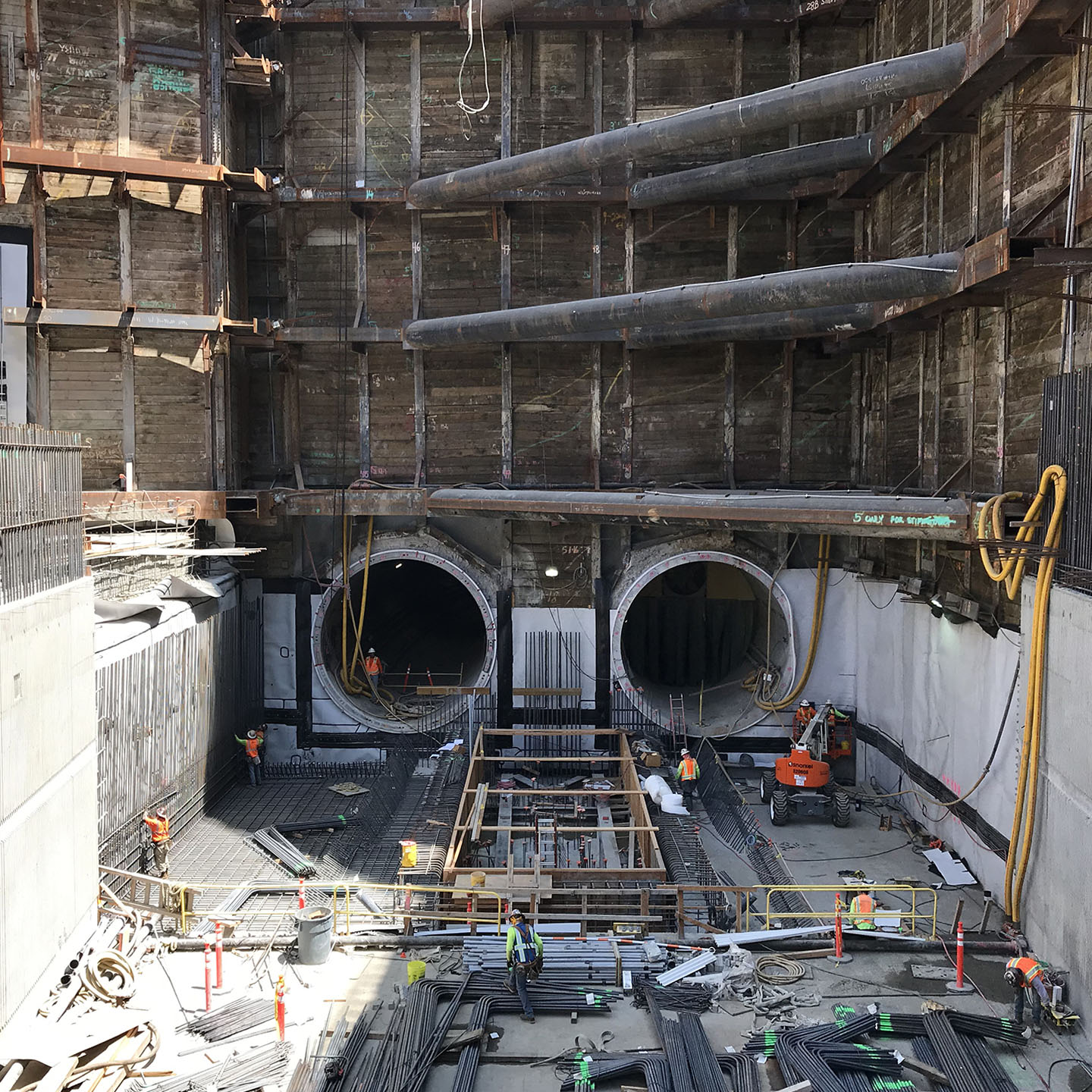Case Study
Optimizing operations for complex construction projects
Skanska USA Civil streamlines processes using Procore to tackle community-shaping Infrastructure initiatives

The Challenge
For Skanska USA Civil, one of the world’s leading civil and infrastructure companies, efficiency is not just an operational concept, but a critical component of success. Multi-year mega projects with extensively self-performed work add additional challenges, such as the need for collaboration, adding a whole additional layer of operational complexity to projects. Before implementing Procore, Skanska faced difficulties in facilitating communication across dispersed teams and stakeholders, tracking expansive project details, utilizing data and more. Large-scale projects like the Lynnwood Link Extension 300 and the Regional Connector meant the need for comprehensive project management, and the company felt the need for improved systems and workflows to simplify operations.

The Solution
After implementing Procore, Skanska gained a more streamlined approach to managing vast and intricate projects. Procore provided an all-in-one solution, allowing teams to monitor progress, manage resources, and ensure quality with increased efficiency. By integrating Procore, Skanska was able to optimize communications, minimize potential project disruptions and enhance stakeholder collaboration. This adoption marks a significant step forward for Skanska as they continue towards a more technologically advanced and cohesive approach to construction management.

The Results
- Achieved timely project completion with 5,794 Punch List Items for the LA Regional Connector project
- Fostered collaboration between Skanska’s civil and building teams, enhancing communication and efficiency on a unified platform
“I couldn't recommend [Procore] any more than I already have. There's nothing to compare — the workflow is atrocious on an Excel sheet. One does it right and the other doesn’t. Reaching out to people I know are assigned to certain things is time-consuming. With Procore, it’s clear what the status of something is, for everyone.”
Rafi Bulatewicz
Project Manager
Skanska
Mastering Communication in Large-Scale Projects
Skanska has been at the forefront of many intricate, large-scale projects. However, the complexity of these ventures comes with their fair share of challenges, especially in terms of communication and collaboration. For instance, in the expansive Lynnwood Link Extension 300 project (L300), the fusion of Skanska’s building and civil teams presented a unique opportunity: utilizing two vernaculars and construction expertise. As Joe Butorac, Skanska’s Assistant Quality Manager on the project, stated, "A unique opportunity has been partnering with the building team. We've learned that civil vernacular and building vernacular are completely different, so bringing people from different business units to speak the same language took a lot of training and collaboration, but it has proven very successful.”
It’s not just about internal alignment, either. With such enormous projects, like the Regional Connector in downtown Los Angeles, external collaboration is vital, too. Working with countless stakeholders necessitated clear, timely communication. Whether needing to update traffic control plans, manage permits or negotiate bid disputes, it’s imperative that Skanska's civil division has every aspect of its projects updated, organized and easily accessible to ensure smooth processes.
Fortunately, after implementing Procore, Skanska's civil division has been able to facilitate timely, accurate communication amongst all of its stakeholders, no matter how big the job. Tim Glaser, Skanska USA Civil’s Director of Project Controls, explained, “We utilize Procore not just to track, but also to collaborate, which has been really helpful. We’re able to work together and have everything visible — everything is transparent; nothing is hidden. I think the collaboration ability has actually been the biggest benefit.” Acting as a singular, centralized platform, Procore has streamlined collaboration efforts, allowing all of those involved in a project to view real-time updates from wherever they may be. Regarding staying aligned and transparent on all sides, Butorac noted, “Using Punch List helps differentiate between actual contract requirements and 'wish list' items. If there's a discrepancy, we address it with the client, referencing the contract.”
Beating Roadblocks and Boosting Efficiency
Another prominent challenge that goes hand-in-hand with civil projects is efficiency. Ensuring mega projects stay on schedule is vital because of their widespread effects, but it's tough to improve efficiency with so many moving parts. When switching to Procore Glaser said, “It's hard to drive consistency when there’s no common ground, so there’s definitely a benefit to using one software, like Procore.”
For Skanska, Procore wasn't just another tech addition — it was an efficiency enhancer. The platform's ability to provide a centralized hub for managing vast amounts of data, tracking progress and ensuring real-time communication turned potential chaos into a choreographed dance of construction precision. And, with particular guidelines to follow throughout projects and unforeseen challenges constantly lurking, precise coordination and efficiency are a need, not a want. For example, In the initial phase of the Regional Connector project, alone, while most earthwork was executed by Skanska, nearly 70 subcontractors were involved. Additionally, the onset and duration of the pandemic caused numerous roadblocks. Rafi Bulatewicz, Project Manager at Skanska, explained, “There were so many unknowns to navigate. But no matter what, keeping an accurate representation of where we’re at and projecting that to the owner is always very important.”
With all of this in mind, Skanska's decision to partner with Procore allowed them to navigate all of these challenges in a connected, yet organized fashion. By providing a comprehensive construction management platform, Procore not only bridged the gaps in communication and coordination, but also centralized data and tasks and offered tools to support efficiency. For the Regional Connector project, Bulatewicz shared, “We started out using the drawing tool — I love the drawing tool. A lot of our contractors started relying on our drawing sets in Procore for the up-to-date drawing modules.” Glaser remarked, “ I upload drawings as they arrive, which are then updated on Procore. Our field team, whether it is building or civil, can download the latest drawings and see any changes. This ensures they're not working off outdated drawings or change orders.”
The Punch List tool has also been pivotal in streamlining Skanska’s processes. Bulatewicz highlighted, “Punch List is probably the tool I use the most, and it's really effective for tracking everything. We’ve created 5,794 Punch list items on the Regional Connector project.” For Butorac, “Having dropdown menus and options for things we're required to fill out really, really makes it easy. Instead of getting just one Excel spreadsheet and a list of 500 locations and issues, we're able to close them out one by one. It’s way more manageable that way.” Glaser chimed in on the matter, explaining, “We can utilize a tool on a project and say, ‘Hey, this one Punch List tool is saving us an inordinate amount of time and creating massive efficiency across the project.’ That's all the return I need to justify paying for the software.”
Scaling Success and Embracing Technological Evolution
Skanska’s civil team, a leading entity within a growing industry, recognizes the role technology plays in shaping the future of construction. With projects of increasing complexity and scale on the horizon, Skanska is committed to harnessing the power of technological tools like Procore to ensure accuracy, efficiency, and seamless execution. For Skanska, partnering with Procore isn’t just about addressing present challenges; it's about preparing for future endeavors. As Skanska continues its growth trajectory, it envisions a construction environment where technology is intertwined with every process, from design to execution.
By leveraging tools like Procore, it aims to anticipate challenges and optimize workflows as much as possible so that it can continue to deliver the highest-quality results in the most timely manner possible, every time. To that point, Glaser expressed, “Consistency and disruption are some of the challenges we face in civil. However, the workforce is changing and younger people are coming in with the desire to use technology, which is going to help us move forward. The civil industry is finally getting to a point where we’re talking about where we could start collecting useful data, and I think it's a problem that's going to be solved very quickly as technology helps us get there.”
He continued, stating, “Using [Procore] helps drive consistency and business practices that are then transferable and ultimately, scalable. And, when you're talking about scalable business practices, you want to be as consistent as you can.” Scalability in construction software is about driving consistent methods, whether it’s for a small-scale project or a mega-infrastructure project. In an industry traditionally grounded in brick and mortar, Skanska’s collaboration with Procore symbolizes a larger industry shift: one where technological evolution and construction evolution walk hand in hand, building the future together.









